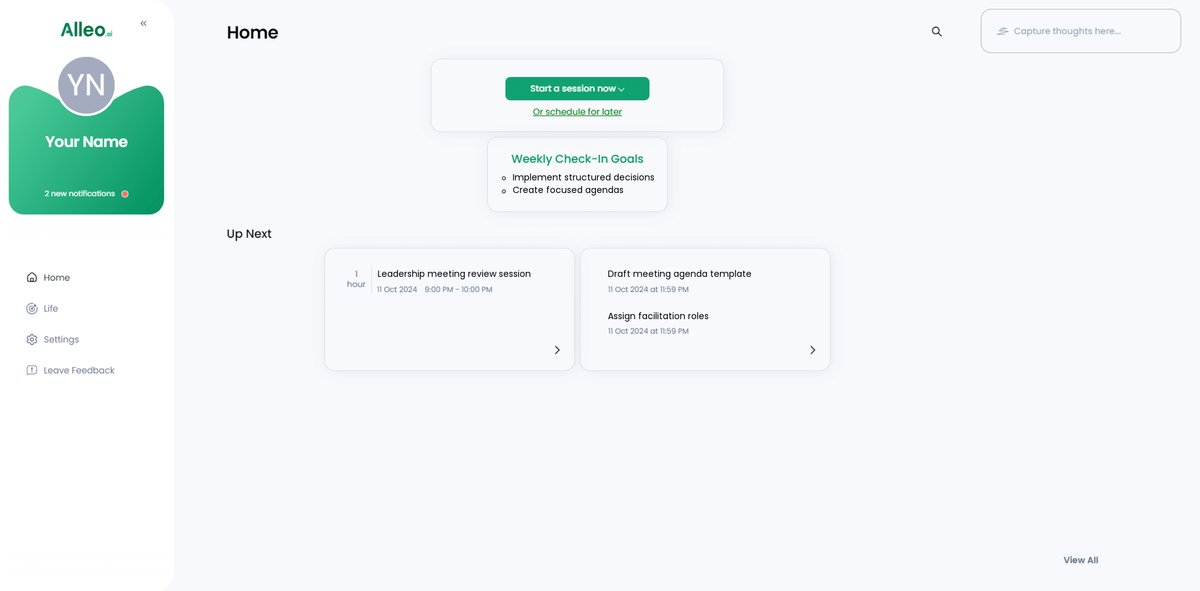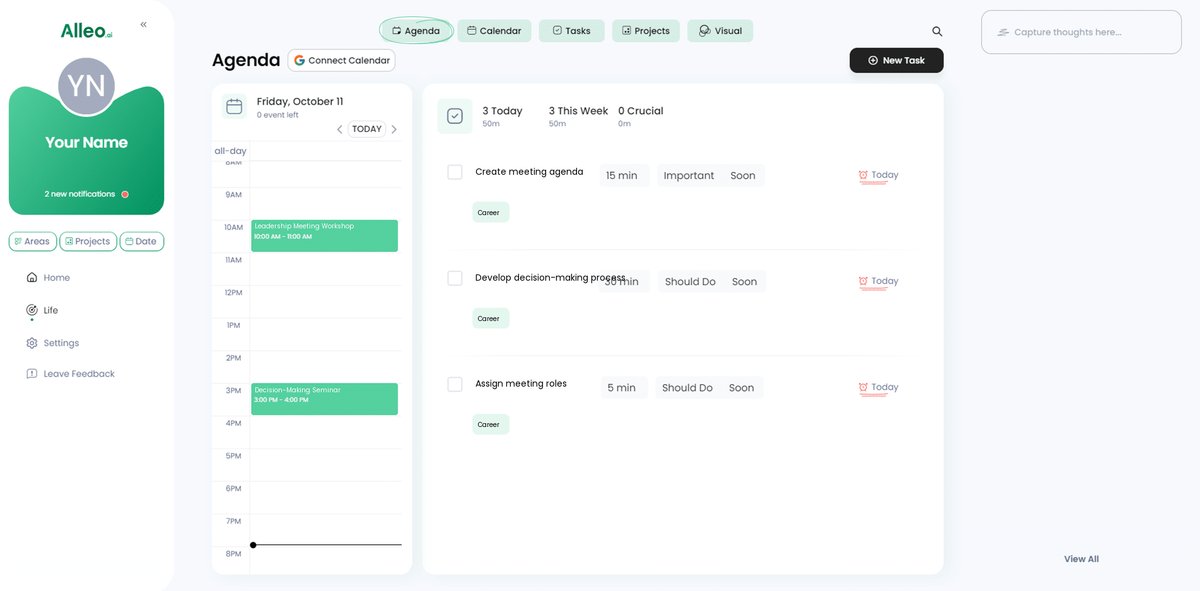How to Structure Leadership Meetings for Better Decision-Making: 3 Proven Methods
Have you ever left a leadership meeting feeling more confused than when you entered?
You’re not alone.
As a life coach, I’ve helped many professionals navigate these challenges. Ineffective meetings can drain energy and hinder progress, highlighting the need for an effective leadership meeting structure.
In this article, you’ll learn how to structure leadership meetings for better decision-making. We’ll cover strategies to enhance coordination and decision-making at different leadership levels, including effective meeting agendas and leadership meeting best practices.
Let’s dive in and explore how to improve team collaboration in meetings and implement time management strategies for leadership gatherings.

The Pitfalls of Ineffective Leadership Meetings
Let’s face it, ineffective leadership meetings are a common struggle for many project managers. Unstructured meetings often leave teams feeling lost and unproductive, highlighting the need for an effective leadership meeting structure.
In my experience, people often find themselves stuck in meetings that lack clear agendas, leading to confusion and wasted time. Implementing effective meeting agendas can significantly improve this situation.
Imagine having a meeting where crucial details are overlooked because there was no proper structure. This scenario isn’t uncommon, and it severely impacts team morale and project outcomes. Leadership meeting best practices can help prevent such issues.
The lack of accountability in these meetings often results in missed deadlines and poor decision-making. Incorporating decision-making frameworks for executives can enhance meeting productivity.
Many clients initially struggle with unstructured meetings that drag on without reaching any meaningful conclusions. These issues not only demotivate team members but also hinder overall project progress. Improving team collaboration in meetings is crucial for overcoming these challenges.
Ineffective meetings can feel like a drain on resources, with no apparent benefits in sight. Implementing time management strategies for leadership gatherings can help address this problem.

Key Steps to Structuring Effective Leadership Meetings
Overcoming this challenge requires a few key steps. Here are the main areas to focus on to make progress in establishing an effective leadership meeting structure:
- Implement a Structured Decision-Making Process: Adopt clear processes for making decisions to ensure effectiveness, incorporating data-driven decision-making in meetings.
- Create Focused Agendas with Clear Objectives: Set specific goals and use effective meeting agendas to stay on track, improving team collaboration in meetings.
- Establish Roles for Meeting Facilitation: Assign and rotate roles to keep meetings productive, facilitating productive leadership discussions.
Let’s dive into these leadership meeting best practices!
1: Implement a structured decision-making process
Implementing a structured decision-making process is crucial for enhancing the effectiveness of your leadership meetings and creating an effective leadership meeting structure.
Actionable Steps:
- Present Proposals with Clear Context and Desired Outcomes: Ensure each proposal includes background information, objectives, and potential impacts. This clarity helps everyone understand the proposal’s importance and supports effective meeting agendas.
- Use Consent-Based Decision Making: Adopt the “safe to try” approach for decision-making. This method encourages quicker implementation and reduces the need for unanimous agreement, aligning with leadership meeting best practices.
- Follow a Structured Process: Implement the steps of Integrative Decision Making (IDM): Present Proposal, Clarifying Questions, Reaction Round, Seek Consent. This structured approach ensures all voices are heard and decisions are well-informed, improving team collaboration in meetings.
Benefits of structured decision-making:
- Increased efficiency in reaching conclusions
- Better alignment among team members
- Reduced chances of overlooking important factors
Explanation:
These steps matter because they provide a clear framework for making decisions, reducing the confusion and inefficiency often seen in unstructured meetings. They form the foundation of an effective leadership meeting structure.
For example, using the “safe to try” approach can speed up decision-making without requiring complete consensus, which can be time-consuming. This aligns with time management strategies for leadership gatherings.
Integrating these methods aligns with industry trends that emphasize consent-based decision-making, helping teams move forward more effectively and facilitating productive leadership discussions.
Applying these strategies can transform your meetings into productive sessions where decisions are made efficiently and effectively, ultimately improving the overall effectiveness of leadership meetings.

2: Create focused agendas with clear objectives
Creating focused agendas with clear objectives is crucial for an effective leadership meeting structure.
Actionable Steps:
- Define Meeting Goals and Objectives: Set specific, measurable goals for each meeting. This ensures everyone is aligned and knows what to expect, improving team collaboration in meetings.
- Use Meeting Agenda Templates: Develop and use templates to start meetings with clear goals and stay on track. This helps maintain focus and direction throughout the meeting, enhancing leadership meeting best practices.
- Share Agendas in Advance: Distribute the agenda at least 48 hours before the meeting. This allows team members to prepare and contribute effectively, facilitating productive leadership discussions.
Explanation:
These steps matter because they provide a clear structure, reduce confusion, and keep the meeting focused on key objectives, supporting effective leadership meeting structure.
For example, sharing the agenda in advance can lead to more productive discussions and better-prepared participants, enhancing time management strategies for leadership gatherings.
According to Fellow, using meeting agenda templates can help ensure meetings start with clear goals and stay on track.
By implementing these strategies, your leadership meetings can become more efficient and result-oriented, supporting data-driven decision-making in meetings.
Key elements of an effective agenda:
- Clear meeting objectives
- Time allocations for each topic
- Assigned presenters or discussion leaders

3: Establish roles for meeting facilitation
Establishing roles for meeting facilitation is crucial for maintaining focus and productivity in an effective leadership meeting structure.
Actionable Steps:
- Assign a Meeting Facilitator: Designate a facilitator to keep the meeting focused and productive. Evaluate meeting efficiency and attendee feedback on facilitation, which are key leadership meeting best practices.
- Define Roles and Responsibilities: Assign specific roles such as note-taker, timekeeper, and decision tracker. Assess role effectiveness and clarity of meeting outcomes to improve team collaboration in meetings.
- Rotate Roles Regularly: Rotate facilitation roles to build skills and engagement among team members. Track role rotation frequency and the development of facilitation skills, enhancing time management strategies for leadership gatherings.
Explanation:
These steps matter because they provide structure and ensure accountability during meetings. For example, rotating roles can enhance team engagement and skill development, contributing to facilitating productive leadership discussions.
According to the Harvard PON, facilitative leadership emphasizes collaboration and productivity. By implementing these strategies, your meetings will become more efficient and effective, supporting data-driven decision-making in meetings.
Common meeting facilitation roles:
- Facilitator: Guides discussion and ensures agenda is followed
- Timekeeper: Monitors time and keeps meeting on schedule
- Note-taker: Records key points, decisions, and action items
With these roles in place, you can expect more organized and impactful leadership meetings, enhancing the overall effective leadership meeting structure.
Partner with Alleo for Better Leadership Meetings
We’ve explored the challenges of structuring leadership meetings for better decision-making. Solving these can transform your team’s success and create an effective leadership meeting structure.
But did you know you can work directly with Alleo to make this journey easier and faster?
Step 1: Goal Setting and Tracking
Anecdote: Meet Sarah, a project manager who struggled with disorganized meetings. After using Alleo, she set SMART goals and saw immediate improvements in creating effective meeting agendas.
Alleo helps you set specific, measurable goals and provides reminders to keep you on track, following leadership meeting best practices.
Step 2: Decision-Making Support
Use Alleo’s decision-making frameworks for executives to present proposals and seek consent efficiently.
Track decision-making efficiency and satisfaction with ease, improving team collaboration in meetings.
Step 3: Meeting Facilitation Assistance
Alleo assigns and manages meeting roles, ensuring clear responsibilities and facilitating productive leadership discussions.
Evaluate the impact of Alleo’s facilitation support on meeting productivity and time management strategies for leadership gatherings.
Ready to get started for free?
Let me show you how to create an effective leadership meeting structure!
Step 1: Log In or Create Your Account
To start enhancing your leadership meetings, log in to your Alleo account or create a new one if you’re new to the platform.

Step 2: Choose Your Focus Area
Select “Setting and achieving personal or professional goals” to address the challenges of ineffective leadership meetings and improve your decision-making process, aligning with the strategies discussed in the article for more productive team interactions.

Step 3: Select “Career” as Your Focus Area
Choose “Career” as your focus area to address leadership meeting challenges, enabling you to develop strategies for more effective decision-making and team coordination in your professional role.

Step 4: Starting a coaching session
Begin your journey with Alleo by scheduling an initial intake session to discuss your leadership meeting challenges and create a personalized plan for improving your team’s decision-making process.

Step 5: Viewing and managing goals after the session
After your leadership meeting coaching session, access the goals you discussed by opening the Alleo app and viewing them on the home page, where you can easily track and manage your progress towards more effective meetings.

Step 6: Adding events to your calendar or app
Use Alleo’s calendar integration to add leadership meetings and decision-making milestones, allowing you to track your progress in structuring more effective meetings and improving your team’s decision-making process.

Putting It All Together for Effective Leadership Meetings
By focusing on structured decision-making, clear agendas, and defined roles, you can transform your leadership meetings into an effective leadership meeting structure.
Remember, effective meetings are the backbone of successful project management and implementing leadership meeting best practices is crucial.
With these strategies, including effective meeting agendas and improving team collaboration in meetings, you’ll see a boost in team morale and productivity.
Don’t let ineffective meetings hold you back.
Take action today to enhance your leadership meeting structure.
Try implementing these steps and notice the difference in facilitating productive leadership discussions.
Consider partnering with Alleo for even more support in measuring meeting effectiveness and outcomes.
With the right tools and structure, your meetings can drive your team’s success through data-driven decision-making in meetings.
Let’s make your leadership meetings powerful and productive by incorporating diverse perspectives in leadership decisions.
Ready to get started? Try Alleo for free and see the change in your effective leadership meeting structure.